New York City Council members and agency leaders convened on November 18 to address the growing problem of subway surfing, a dangerous activity that involves riding on top of moving trains. During the oversight hearing, officials discussed strategies to prevent young people from engaging in this hazardous behavior, which has led to an alarming number of fatalities. According to Council Member Selvena Brooks-Powers, chair of the committee on transportation and infrastructure, five people died last year due to subway surfing, while six fatalities have been recorded this year.
The discussion emphasized the role of social media in encouraging the trend, particularly among the approximately 350,000 public school students who use the subway daily. Representatives from the Metropolitan Transportation Authority (MTA), the NYPD, and NYC Public Schools all identified social media as a significant driver of the issue. Michael Kemper, MTA’s chief security officer, revealed that the agency actively monitors platforms like Facebook, Instagram, TikTok, and Snapchat to remove content promoting subway surfing, flagging over 10,000 posts for deletion so far.

NYPD Chief of Transit Joseph Gulotta highlighted that the average age of subway surfers is 14, with some offenders as young as nine. He noted that the trend is exacerbated by the desire to create and share risky content on social media, a phenomenon not seen in previous decades. To counteract the issue, the NYPD has introduced initiatives such as home visits to educate parents about the dangers their children face. Gulotta stressed that these interactions often help parents understand the seriousness of the behavior.
To enhance surveillance, the NYPD has deployed drones in areas with high incidents of subway surfing, especially during the school year. MTA data shows that incidents peak in warm weather and after school hours, with a significant decrease during the summer months. The 7 train in Queens is particularly popular among subway surfers due to its elevated, flat, and scenic route, making it ideal for capturing dramatic videos.


During the hearing, Brooks-Powers inquired about possible infrastructure modifications to discourage subway surfing, such as redesigning emergency exits to prevent access to train roofs. MTA officials noted that any changes would need to balance safety during emergencies and for maintenance workers. Additionally, Brooks-Powers questioned the effectiveness of the “Subway Surfing Kills: Ride Inside, Stay Alive” public awareness campaign, which was launched last year by Mayor Eric Adams and the MTA. The campaign includes student-produced public service announcements, digital signage, posters, and outreach in schools.
MTA officials reiterated that parental involvement is crucial in curbing subway surfing. Kemper emphasized the impact of parents seeing surveillance footage of their children engaging in the activity, describing it as far more effective than punitive measures like arrests. This year, the NYPD has arrested 163 individuals for subway surfing, a 22% increase from the 138 arrests made in 2023.
Officials and community leaders continue to stress the importance of collaboration between parents, schools, and law enforcement to address the root causes of subway surfing and prevent further tragedies.